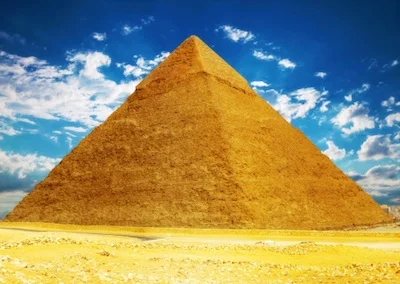In ancient times the Greeks made a list of the wonders of the world at that time.
There were seven of them, so they are known as the Seven Wonders of the Ancient World.
Only the Great Pyramid remains today.
What is the ‘Ancient World’?
It was in the time called BC or BCE. BC means 'before Christ' but today the term BCE, or 'Before the Common Era' is the preferred term because it is not about Christianity.
The term AD refers to dates after the birth of Christ and has similarly been changed to CE, or 'Common Era'.
Illustration©Getty Images
The Colossus of Rhodes
This was a 33m high bronze statue built on the Greek island of Rhodes between 292 and 280 BCE. It was of the Greek god Helios, and stood on a 2 m high platform of white marble. One of the tallest statues of the ancient world, it stood for 56 years, but was destroyed in a huge earthquake. It was said by Pliny the Elder, a famous Roman author and naturalist, that even lying in pieces on the ground, it was a marvel.
Some people believe the statue had one foot on each side of the harbour, but archeologists now think that it is unlikely.
The Great Pyramid of Giza
The pyramid today. Photo©Getty Images
It was built around 2550 BCE. Standing 147m high, it is the largest pyramid ever built, consisting of 2.3 million stone blocks, weighing up to 13 tonnes each. It is the final resting place of the Pharoah (king) Khufu, with three burial chambers, the third being in the exact centre of the pyramid, and the one where Khufu's sarcophagus (coffin) was placed. Pyramids had tunnels and chambers of treasures for the soul to take to the next world. An elaborate system of sliding granite blocks sealed off the chambers in order to defeat would-be thieves.
The Hanging Gardens of Babylon
Illustration©Getty Images
The city of Babylon stood alongside the Euphrates River in what is now Iraq. The Hanging Gardens were built around 600 BCE and are long gone. The gardens didn't actually hang, but draped over the sides of a terraced brick structure. From ancient writings we know that the gardens were the height of a five storey building, with thick walls, that there were several layers of plants and a complex irrigation system that took water from the river up several layers of garden. In a desert city, the lush plants and blooms would have been a wonder, let alone the engineering required to build and maintain a water supply.
The Lighthouse of Alexandria
Illustration©Getty Images
It stood on the island of Pharos in the harbour of the Egyptian city of Alexandria. Construction began in 290 BCE and took 20 years to complete. Made of white marble, it stood about 135m high, and from the top, ships over a hundred km away could be seen.
The lighthouse had three sections: the first was square, the next section was octagonal and the top section was circular. At the top, mirrors reflected the light of the sun during the day and the light from a fire during the night. It was destroyed by two earthquakes. In 1994, some of the remains were found by divers.
The Mausoleum of Halicarnassus
Illustration©Getty Images
The city of Halicarnassus was in Asia Minor, an area that covers much of modern day Turkey. It is the tomb of a king, Mausolus. When he died, the queen decided he would have the largest tomb ever built. Stone lions guarded the stairway leading to the 43m high building. The middle section contained many Greek columns, and the top section was a pyramid. At the very top there was as statue of the king and his wife.
The queen died just two years after her husband, but the builders stayed on to finish the tomb.
The Statue of Zeus at Olympia
Illustration on a stamp. ©Getty Images
Zeus was the king of the gods of ancient Greece. It was believed that the gods lived on Mount Olympus, and Olympia was the sacred site where the Olympic Games were held.
Written accounts described a huge temple, with bronze doors that opened to reveal the enormous statue inside. It was said that people shuddered and cowered in its shadow. Made of gold and ivory, it took eight years for the artist Phidias to complete the statue of the god seated on a jewelled throne.
The statue was 12m high, and writers noted that if Zeus stood up, his head would go through the ceiling. It is believed the statue was first placed in the temple around 450 BCE. It was later moved to safety to Constantinople, before Christians shut down the temple in 391 AD. Close to around 500 AD the statue was destroyed in a fire.
The Temple of Artemis at Ephesus
Illustration©Getty Images
Ephesus was a city in what is now Turkey, and is where a temple to the goddess Artemis was built around 650 BCE. It was built on marshland as a precaution in a land where earthquakes are not uncommon. It was rebuilt three times. After being destroyed in the 7th century, perhaps in a flood or perhaps in a war, a much larger version was built on the same site. This one burned down. Many years later it was rebuilt again, of marble. This temple lasted for 600 years before the Goths destroyed it, and it was never rebuilt.









